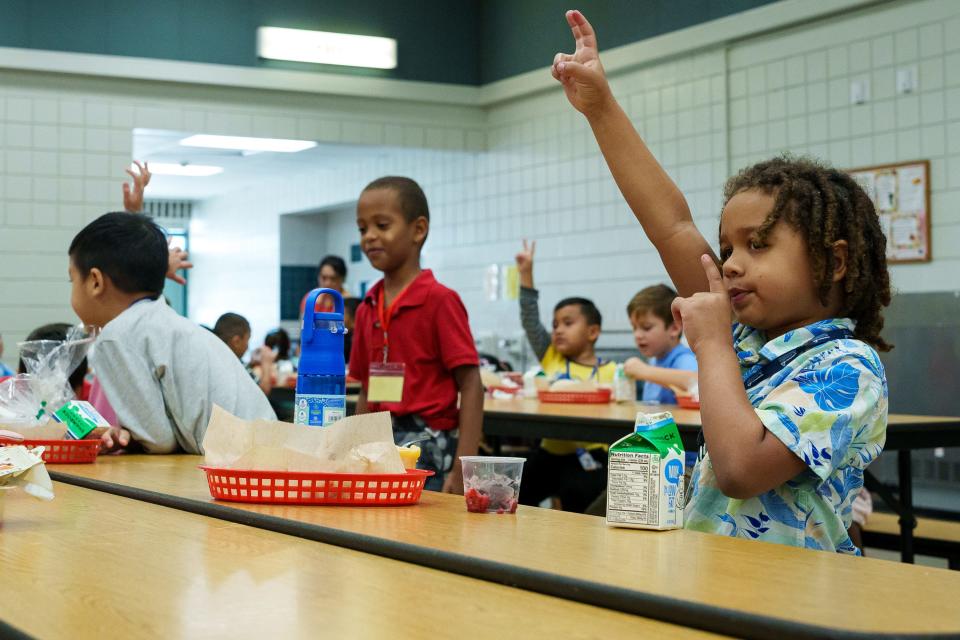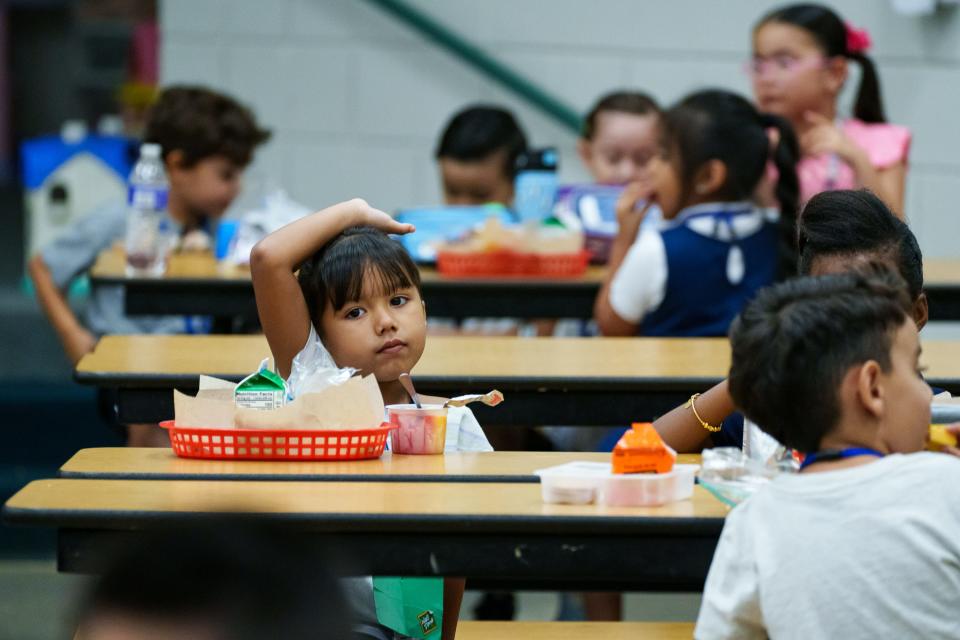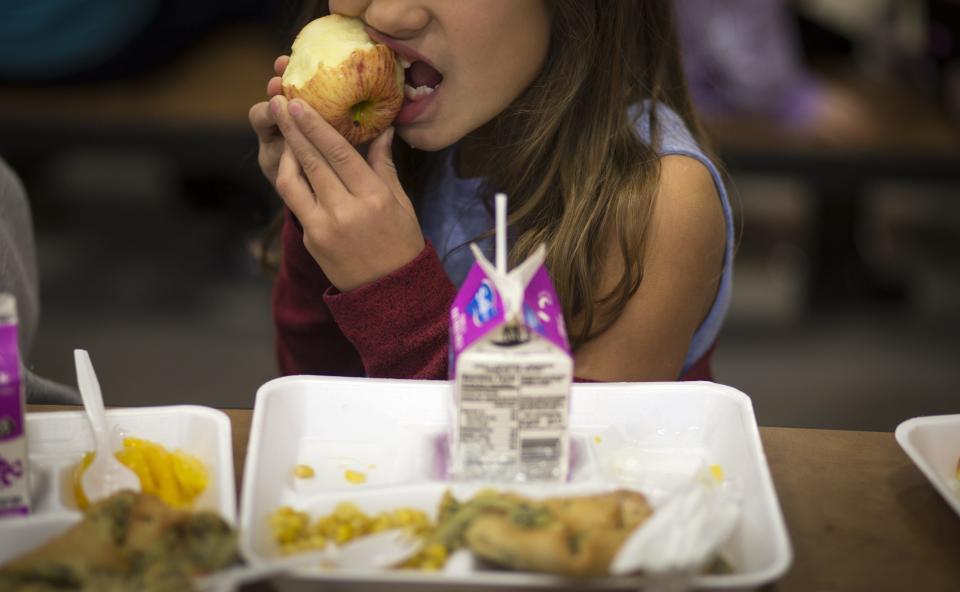Hundreds of Arizona schools made breakfast and lunch free for all students. What to know
A growing number of schools across Arizona are offering free meals to all students, and school leaders say the change has helped families who don't qualify for free meals but still struggle to afford the costs.
More than 260 schools across the state this spring made breakfast and lunch free for all students through a federal reimbursement program called the Community Eligibility Provision, according to the Arizona Department of Education.
The decisions came as a $6.75 million pandemic relief fund investment from the Arizona Department of Education that made meals free for students who qualify for reduced-price meals is set to expire at the end of this school year.

Created in 2010 and administered through the Food and Nutrition Service of the U.S. Department of Agriculture, the program allows high-need schools to serve free breakfast and lunch to all students without requiring applications from families. To qualify, a certain percentage of a school or district's students must be deemed eligible through their participation in another federal assistance program, including SNAP or TANF.
In Arizona, the list was expanded this school year to include Medicaid, paving the way for more schools to become eligible for the program.
Twenty-one Arizona school districts made meals free for all students this spring through CEP after the program allowed a mid-year election. Other districts, including Mesa Public Schools, increased the number of schools that provide free meals to all kids. Many charter schools joined the program as well.
The program lasts for four years before schools must reapply.
Free school meals for all students have made a "tremendous difference," according to Lupita Hightower, the superintendent of Tolleson Elementary School District, which joined the program in 2022. Paying meal fees "gets very difficult for families," especially in a household of four or five, she said.

Nora Ulloa, the superintendent of the Fowler Elementary School District, which made meals free for all kids in March, said the change has improved the district's relationship with parents and increased the number of school meals being served.
A majority of the district's students qualify for free or reduced meals. But if a family doesn't qualify for free meals and can't afford the price, "that adds up," Ulloa said. "You never know what families are contending with." To qualify for free school meals, a family of four must have an annual household income of at or below $39,000. Four-person households between $39,000 and $55,500 qualify for reduced-price meals and can't be charged more than 30 cents for breakfast and 40 cents for lunch.
"It got to the point where it felt like we were making kids uncomfortable by repeatedly reminding them that they had a bill outstanding, and it’s really not the kid’s fault," Ulloa said. The majority of the district's parents are "doing the best they can," she added.
Some school employees would pay for the meals of kids who had outstanding balances, she said, and teachers and cafeteria employees would be the ones "stuck in the middle" asking parents to pay.
Since making the change, Fowler Elementary has seen an increase in the number of school meals being served. "It's just a non-issue now," Ulloa said. And the parent relationship is "a lot more positive," she said.

Tempe Elementary School District made meals free for all students across 22 schools in February — formerly, they had only been available at eight schools.
Before the change, the district didn't turn students away from meals for having outstanding bills. But district families have a total of $263,000 in meal debt, according to spokesperson Gabi Dunton.
Now, more students are opting to eat the lunch offered by the school. "It eliminates that stigma that this program is only for students" who can't afford it, said Janay Watts, the district's nutrition services director. And it eliminates barriers for families who couldn't afford the meal prices, she said.
Between February and April, the number of lunches served per day rose from roughly 6,800 to around 7,200 to 7,300, Watts said. "And it's growing every day," she said.
For Pendergast Elementary School District, the change has freed up time for school leaders who no longer have to process applications for free and reduced-price meals, according to Jamie Triolo, the district's director of food services.
Participation in school meals has been linked to improved attendance, behavior and academic achievement, according to Crystal FitzSimons, the child nutrition programs and policy director at the Food Research and Action Center.
"By making school meals more accessible, more kids are going to benefit from those," FitzSimons said.
Meals served through federal programs must meet certain nutrition requirements, and according to the Centers for Disease Control and Prevention, students who participate in school meals consume more whole grains, milk, fruits and vegetables during mealtimes than nonparticipants.
"When kids aren't eating, they're crabby," said Ulloa, the Fowler superintendent. "They're not learning."
A growing trend nationwide
Before the COVID-19 pandemic, about one in three schools across the country were offering free meals to all kids, according to FitzSimons. Then, when the pandemic hit in 2020, nearly all schools began offering universal free meals through a temporary waiver passed by Congress. "It was really a trial run for nationwide healthy school meals for all," FitzSimons said, calling it a "huge success."
That waiver expired in 2022, and when schools returned to normal meal operations for the 2022-23 school year, the program grew from around 33,000 schools to over 40,000 nationwide.
In Arizona, more than 500 schools participated in the program during the 2022-23 school year, according to a report from the Food Research and Action Center. Some districts, including the Phoenix Union High School District, offer free meals to all kids through other federal programs.
Still, other school districts across the Valley are raising meal prices for next school year, including the Littleton elementary school district.
Even as CEP participation expands, not all schools that are eligible find it financially viable, FitzSimons said. The number of meals reimbursed at the federal free rate is determined by the percentage of eligible students, and the remaining meals are reimbursed at a much lower rate.
"The places where we really are expecting to see the big upticks are from districts who are committed to putting additional funding into supporting the program," FitzSimons said. Some states subsidize the difference for schools.
Others have gone further in investing in free school meals: eight states, including California and New Mexico, have passed laws making breakfast and lunch free for all students regardless of household income.
Reach the reporter at mparrish@arizonarepublic.com.
This article originally appeared on Arizona Republic: Hundreds of Arizona schools adopt universal free school meals

